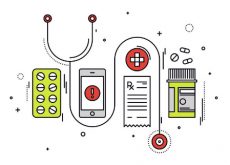In working with HL7 interfaces in Healthcare IT, you will at some point have to troubleshoot lab orders and results. If you have no knowledge of HL7 messages and interfaces, first drop by this page on HL7 interfaces for a primer, then come back here.
When an order is placed for a lab test, the HL7 message contains an identifier that is unique to this particular order, or possibly a set of orders placed at the same time. This is the placer order number field, and its main purpose is to link the orders placed with the results that come back to the physician from the lab electronically.
In an HL7 message, the placer order number is in the OBR;2 field, shown in bold in the HL7 message below:
MSH|^~\&|HIS|EPIC|LAB|HOSP|20140307110114
||ORM^O01|07110114|P|2.3
PID|||12001||SIMPSON^HOMER||19670824|M|||123 Fake St.^^Springfield^OR^90020^USA|||||||
PV1||O|OP^PAREG^||||2342^SIMPSON^HOMER|||OP|||||||||2||||||||
|||||||||||||||||20140307110111|
ORC|NW|20151122945
OBR|1|20151122945||12345^Urinalysis^L|||20140307110114
After the lab or clinic collects from the patient, the sample is processed by the lab, and the results are sent back to the ordering provider via the results interface. The same placer order number is sent back with the results to link them to the correct patient and provider. The lab also has a filler order number unique to them which is stored in OBR;3. The OBR;3 field is sometimes called the accession number. Both fields are in bold in the HL7 message below:
MSH|^~\&|HIS|EPIC|LAB|HOSP|20140307110114||ORM^O01|07110114|P|2.3
PID|||12001||SIMPSON^HOMER||19670824|M|||123 Fake St.^^Springfield^OR^90020
^USA|||||||
PV1||O|OP^PAREG^||||2342^SIMPSON^HOMER|||OP|||||||||2|||||||||||||||||
||||||||20140307110111|
ORC|RE|20140307110114
OBR|1|20151122945|L99201403|12345^Urinalysis^L|
OBX|1|NM|013060^Specific Gravity^L||1.010||1.005-1.030|||N|F|
OBX|2|CE|013045^Urine-Color^L||Y^Yellow^L||Y|||N|F|
OBX|3|ST|013052^Appearance^L||Hazy||Clear|A||N|F|
This standard ensures that lab results and orders are properly linked, formatted, and displayed to the provider and anyone else who has access to the electronic health record. If results end up going back to the wrong patient, it’s almost certainly caused by human error.

Read More

